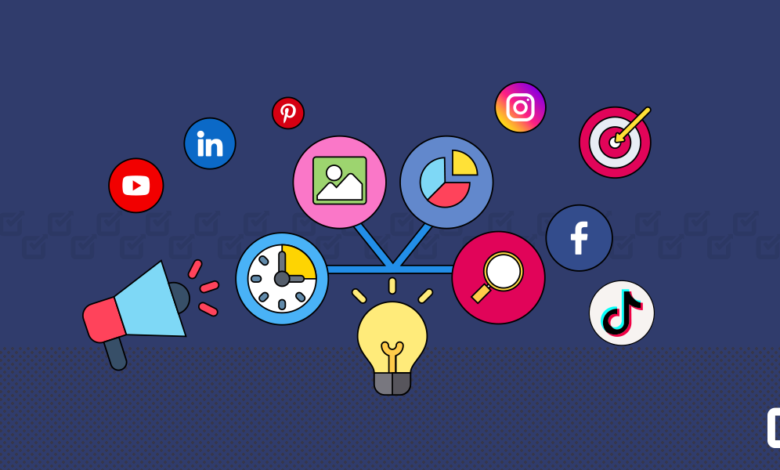5 Tips on Maximizing Your Brand’s Reach Through Strategic Social Media Campaigns

Social media has become an inseparable tool for brands looking to expand their reach.
In fact, according to Statista data, over 4.9 billion people around the world are using social media as of 2023, making it a powerful platform to connect with a vast audience.
But how can your brand stand out and effectively reach these billions of users?
The key lies in running strategic social media campaigns that capture attention and drive engagement.
In this article, we’ll share five actionable tips to help you maximize your brand’s reach and make a lasting effect on social media platforms.
Tip 1: Define Clear Objectives and KPIs
Establishing distinct objectives and key performance indicators (KPIs) is the cornerstone of a successful social media campaign.
These serve as the compass, guiding your campaign toward success and enabling you to pinpoint areas for enhancement.
As per CoSchedule, marketers who proactively set goals are 376% more likely to achieve successful outcomes.
This underscores the pivotal role of clear objectives and KPIs in the initial stages of your campaign.
First, consider what you want to achieve with your social media efforts.
Do you want to increase brand awareness, drive website traffic, generate leads, or boost customer engagement?
Your objectives should match your overall marketing strategy and be SMART (Specific, Measurable, Achievable, Relevant, Time-bound). For example:
- Increase Brand Awareness: Track metrics like reach, impressions, and follower growth.
- Boost Engagement: Focus on likes, shares, comments, and overall engagement rates.
- Drive Conversions: Monitor clicks, conversion rates, and sales directly attributable to social media efforts.
Once your objectives are in place, the next step is to establish KPIs.
These yardsticks will help you gauge your progress and determine if you’re on the right track.
Common KPIs include:
- Engagement Rate: The percentage of your audience interacting with your content (likes, comments, shares, etc.).
- Click-Through Rate (CTR): The number of people who click your link compared to the total number who view it.
- Conversion Rate: The percentage of users who have done a desired action, like signing up for a newsletter or purchasing a product.
- Return on Investment (ROI): Calculate how much revenue your social media efforts generate compared to the costs involved.
Tip 2: Know Your Target Audience
A successful social media campaign hinges on how well you know your audience.
With a deep understanding of who you’re speaking to, your messages may stay flat, no matter how creative or compelling they seem.
Research by Sprout Social shows that 72% of consumers anticipate brands to know their unique needs and what they want, which means understanding your audience is more critical than ever.
To truly connect with your audience, it’s necessary to segment them based on demographics, behaviors, interests, and even purchasing habits. Here’s how you can begin:
- Use Analytics Tools: Start by leveraging analytics from your social media platforms (Facebook Insights, Instagram Insights, LinkedIn Analytics) to understand your followers’ age, gender, location, and behaviors.
These tools can reveal key insights, such as which posts resonate most and when your audience is most active.
- Create Audience Personas: Develop personas that represent your perfect customers. These personas should include demographic information, interests, pain points, and social media habits. For example, a persona for a beauty brand might be “Sara, a 25-year-old professional who follows beauty influencers and engages with tutorials on Instagram.”
Having these personas helps guide your content creation process and ensure your messaging is tailored to your audience’s needs and preferences.
- Conduct Social Listening: Social listening tools (such as Hootsuite or Sprout Social) allow you to monitor conversations, keywords and mentions related to your industry or brand.
By paying attention to what your audience is saying, you can better understand their concerns, preferences, and pain points. This information can help you craft messages that truly resonate and address their needs.
- Survey Your Audience: Don’t be afraid to ask your audience directly what they want.
Run surveys or polls on platforms like Instagram Stories or Facebook to gather feedback about the types of content they prefer, what motivates them to engage, and their overall interests.
- Tailor Content to Specific Audiences: Once you have gathered all this data, customize your content to different audience segments. For example, if you have a younger and older demographic, consider creating separate campaigns for each, focusing on various types of content or messaging that align with their interests.
A younger audience may prefer short, engaging video content, while an older demographic might respond better to detailed, informative posts.
Understanding your audience also means recognizing which platforms they are most active on.
While Instagram might be ideal for targeting millennials with visual content, LinkedIn could be the better choice for reaching professionals with B2B-focused messaging.
Knowing your audience lets you create more personalized, targeted, and effective social media campaigns.
If managing this seems overwhelming, partnering with a social media marketing agency can assist you in developing and executing a tailored multi-platform strategy that ensures your brand reaches its full potential.
Tip 3: Leverage Multi-Platform Strategies
Leveraging multiple social media platforms in your strategy is crucial to truly expanding your brand’s reach.
Each platform has its specific audience and features, so relying on just one may limit your ability to connect with your target customers.
For instance, Instagram’s visual focus makes it perfect for showcasing products, while LinkedIn is more suited for B2B content and professional insights.
Customize your content to fit the strengths of each platform while maintaining consistency in your brand’s voice.
Cross-promote your content by encouraging followers on one platform to engage with your content on another without simply duplicating posts.
For example, you could offer exclusive insights on LinkedIn while driving traffic from your Instagram Stories.
Use platform-specific tools like Instagram Reels, Twitter polls, or LinkedIn groups to increase engagement and build a community.
Tip 4: Create Compelling, Shareable Content
Creating content that connects and resonates with your audience is key to driving engagement and increasing your brand’s reach.
But your content needs to be engaging and shareable to make an impact.
Here are some ways to create content that encourages your audience to spread the word:
- Focus on Visual Appeal: Use high-quality images, videos, and infographics to capture attention. Posts with visuals are usually shared more as they stand out in crowded social feeds.
- Tell a Story: People connect with stories. Craft narratives that evoke emotions through customer testimonials, behind-the-scenes looks, or real-world applications of your product. Storytelling builds emotional connections and makes content more shareable.
- Provide Value: Educational or how-to content is highly shareable because it offers immediate value. Whether it’s a tutorial, tips, or industry insights, ensure your content solves a problem or answers a question your audience has.
- Incorporate User-Generated Content (UGC): Encourage your audience to create content for you by sharing their experiences with your products or services. UGC builds trust and amplifies your reach when users share their contributions with their networks.
- Use Trending Hashtags and Challenges: Participate in popular trends, hashtags, or social media challenges relevant to your brand. This can increase your visibility and chances of going viral, as people are likely to engage with content tied to trending topics.
Tip 5: Utilize Paid Social Media Advertising
While organic reach is necessary, incorporating paid social media advertising into your strategy can significantly enhance your brand’s visibility.
Paid ads let you target particular demographics, interests, and behaviors, making sure your content reaches the right audience at the right time.
Whether using Facebook Ads, Instagram Sponsored Posts, or LinkedIn Ads, paid campaigns provide precise control over who sees your content.
Start by setting clear ad goals, such as increasing website traffic, generating leads, or boosting sales.
Use A/B testing to optimize your campaigns by experimenting with various ad creatives, copy, and targeting options to see what works best.
You can adjust your budget in real time, ensuring you get the most value for your spending.
One of the benefits of paid social media advertising is the ability to retarget users who have previously interacted with your brand.
Retargeting ads remind potential customers about your offerings, helping to increase conversion rates.
When combined with organic strategies, paid ads can amplify your social media presence and help you achieve faster, more measurable results.
Conclusion
Maximizing your brand’s reach through strategic social media campaigns requires a balanced approach that combines clear goals, deep audience insights, multi-platform strategies, engaging content, and intelligent use of paid advertising.
You can continuously optimize your efforts by setting well-defined objectives and tracking your performance with the right KPIs.
Understanding your target audience lets you deliver content that resonates, while a multi-platform strategy ensures you’re reaching them where they are most active.
Compelling, shareable content helps you organically expand your reach, and paid ads can further amplify your visibility and conversions.
When executed together, these five strategies will boost your brand’s presence on social media and strengthen your overall digital marketing efforts.
Implementing these tips will allow you to watch your brand’s social reach grow, connecting with new audiences and driving meaningful engagement.
The benefits of these strategies are clear, and the potential for your brand is significant.
Remember, social media success doesn’t happen overnight, but your brand will reap the rewards with a consistent, strategic approach.
Keep an eye for more news & updates on Tech Pro Magazine!





